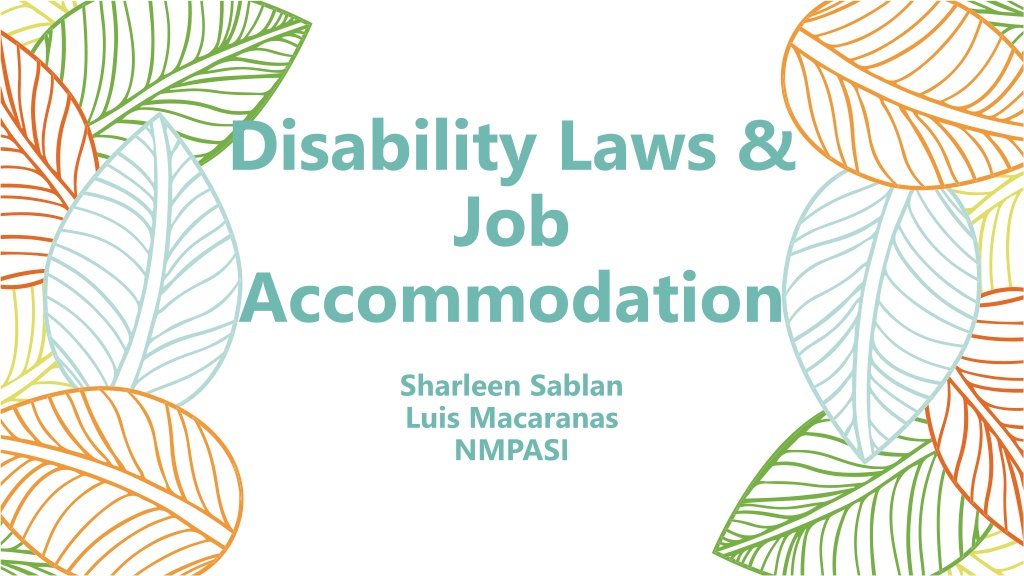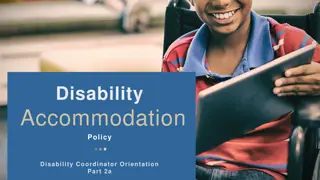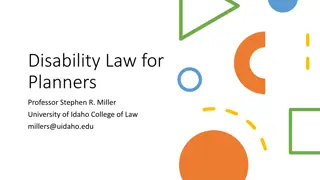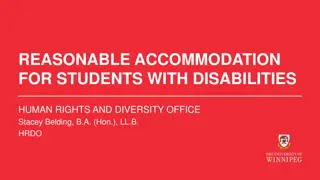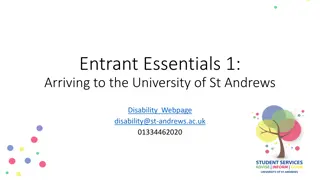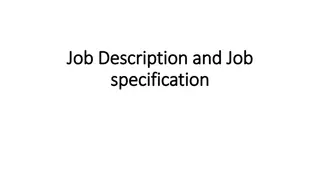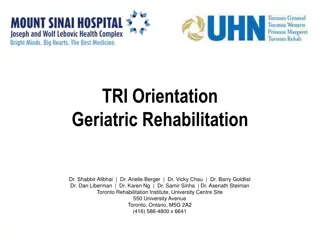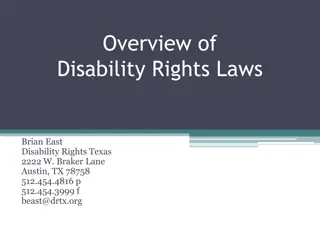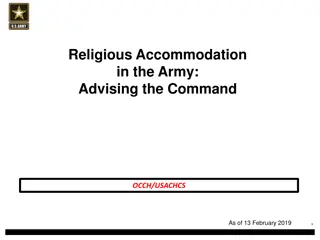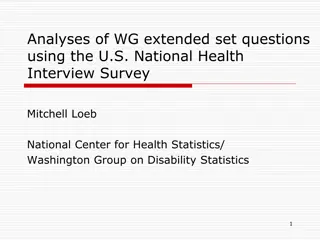Understanding Disability Laws and Job Accommodation
Northern Marianas Protection and Advocacy System Inc. (NMPASI) aims to protect the rights of individuals with disabilities. The learning goals include understanding disabilities, relevant laws, and reasonable accommodations in the workplace. This presentation highlights the importance of addressing attitudes and stereotypes to ensure equal opportunities for people with disabilities.
Download Presentation

Please find below an Image/Link to download the presentation.
The content on the website is provided AS IS for your information and personal use only. It may not be sold, licensed, or shared on other websites without obtaining consent from the author. Download presentation by click this link. If you encounter any issues during the download, it is possible that the publisher has removed the file from their server.
E N D
Presentation Transcript
Disability Laws & Job Accommodation Sharleen Sablan Luis Macaranas NMPASI
NMPASI Northern Marianas Protection & Advocacy System Inc Established in 1993 To Protect the civil, legal, and human rights of individuals with disabilities Goals Provide legally based advocacy services for people with disabilities and their families in the CNMI Advance the understanding of P&A services and other disability related issues in the CNMI Voices For those who are unable to speak
Learning Goal and Objectives Goals Ensure all members of the community are treated with dignity and respect to create an environment free from disability related discrimination and harassment. Objective What is a disability Have a basic understanding Laws that protect individual with disabilities Basic Understanding of the Family Medical Leave Act (FMLA) What are reasonable accommodation Employee Privacy
Why is this presentation important There are 2,949 people with disability in the CNMI, that 5% of the total population Out of the CNMI disability population 18% or 1905 are within the legal age group of employment. People with disabilities in the United States, making up an estimated 20% of the total population. There are 133 million people in the United States living with a chronic health condition. That number is expected to increase to 150 million by 2030 Attitudes and stereotypes remain the main barriers to successful employment reported by people with disabilities.
What is a disability? The ADA defines a person with a disability as a person who has a physical or mental impairment that substantially limits one or more major life activity. This includes people who have a record of such an impairment, even if they do not currently have a disability. It also includes individuals who do not have a disability but are regarded as having a disability. The ADA also makes it unlawful to discriminate against a person based on that person s association with a person with a disability. Record of such an impairment, even if they do not currently have a disability. Regarded as having a disability. Person sassociation with a person with a disability.
LAWS TO KEEP IN MIND American with Disability Act Rehabilitation Act Vietnam Era Veterans Readjustment Assistance Act
American with Disability Act (ADA) The Americans with Disabilities Act (ADA) prohibits discrimination against people with disabilities and guarantees equal opportunities for individuals with disabilities in employment, transportation, public accommodations, state and local government services, and telecommunications. Title I: Employment prohibits covered employers from discriminating against people with disabilities in all employment-related activities, including hiring, pay, benefits, firing and promotions. Title II: State and Local Governments protects people with disabilities from discrimination in state and local government services, programs and activities. Title III Public Accommodation & Commercial Facilities prohibits discrimination on the basis of disability in the activities of places of public accommodations
Rehabilitation Act The Rehabilitation Act authorizes funding for various disability-related purposes and activities, including state vocational rehabilitation (VR) programs, independent living programs, training and research, and the work of the National Council on Disability Section 501 of the Rehabilitation Act prohibits federal employers from discriminating against qualified individuals with disabilities and requires them to take affirmative action to employ and advance in employment qualified individuals with disabilities. Section 503 of the Rehabilitation Act prohibits employment discrimination based on disability and requires affirmative action in the hiring, placement and advancement of people with disabilities by federal contractors or subcontractors who have federal contracts or subcontracts in excess of $10,000. Section 504 of the Rehabilitation Act prohibits discrimination against qualified individuals with disabilities by federal agencies, or by programs or activities that receive federal financial assistance or are conducted by a federal agency.
Vietnam Era Veterans Readjustment Assistance Act (VEVRAA) The Vietnam Era Veterans' Readjustment Assistance Act (VEVRAA) requires employers that have federal contracts or subcontracts entered into before December 1, 2003 of $25,000 or more and/or federal contracts or subcontracts entered into on or after December 1, 2003 of $100,000 or more to provide equal employment opportunities for certain veterans with disabilities. VEVRAA's Section 4212 specifically prohibits discrimination against covered veterans with disabilities in the full range of employment activities.
Family Medical Leave Act The Family and Medical Leave Act (FMLA) provides certain employees with up to 12 weeks of unpaid, job-protected leave per year. It also requires that their group health benefits be maintained during the leave. FMLA is designed to help employees balance their work and family responsibilities by allowing them to take reasonable unpaid leave for certain family and medical reasons. Twelve workweeks of leave in a 12-month period for: To take medical leave when the employee is unable to work because of a serious health condition. For the birth and care of the newborn child of an employee; For placement with the employee of a child for adoption or foster care; To care for an immediate family member (i.e., spouse, child, or parent) with a serious health condition
FMLA Cont Employee that qualify Work for a covered employer Work a total of 1,250 hours during the prior to the start of leave Work at a location where 50 or more employees work at the location or 75 miles of it Have worked for an employer for 12 months. Military- Uniformed Service Employment and Reemployment Rights Act of 1994 (USERRA)
FMLA cont Employers that Qualify Private sector Employers If it employs 50 or more employees in 20 or more workweek in the current or previous calendar year Public Agency Public agencies are covered under FMLA, regardless of the number of employees they employ Federal Government USPS Postal Regulatory commission Federal Aviation Administration The judicial branch of the United States Schools Public school boards Public elementary and secondary schools Private elementary and secondary school
What are reasonable accommodations? A reasonable accommodation is any modification or adjustment to a job, practice, policy, or the work environment that allows an individual with a disability to participate equally in an employment opportunity. Examples include: Making existing facilities accessible Modifying a work schedule Altering training materials, tests, or policies Acquiring or modifying equipment Providing an interpreter Restructuring a job Leave without pay Reassignment to a vacant position
Thing to keep in mind about Accommodation Preferred vs. Effective Undue hardship Personal service or device Removing essential functions
Scenario: Maria Si Maria, a computer specialist, has fibromyalgia and experiences flare ups of major fatigue and pain affecting her ability to perform manual tasks such as walking and daily household chores. She has requested a flexible work schedule and the ability to work from home which would require the use of a computer and remote access. -Are Maria requests reasonable? -What if Maria s job was a line cook? Would her request for a flexible work schedule and ability to work from home be reasonable?
Scenario: Juan Juan, a receptionist, recently lost most use of his right arm. He informs his supervisor that performing certain office tasks takes him much longer with his left hand. His supervisor replied that Juan still needs to meet deadlines. -Did Juan request an accommodation? -Did the employer engage in the interactive process? -Does Juan have to meet the deadlines with or without a reasonable accommodation?
Employee Privacy: Medical Information Medical information is not shared with a supervisor Accommodation information is shared on a need-to-know basis Co-workers not entitled to any medical information Human Resources stores all medical Information
Employee Privacy: Medical Inquiries Applicants No questions about medical status, medical history, disabilities, or severity of any medical condition Can ask if they can perform job functions Employees No questions about medical status, medical history, family medical history, or specifics about disabilities or medical conditions Tell employees that you are concerned, but you cannot discuss these issues with them for employee s and manager s protection Refer to Human Resources
Thank you Disability Law & Job Accommodation Northern Marianas Protection & Advocacy System Inc (NMPASI) Sharleen Sablan Luis Macaranas
